Causes & Treatment for Thinning Hair in Women Over 50
If you’ve got thin hair like I do, hair loss seems obvious much sooner than it does on women who start with thick hair. My first nasty bout with thinning hair began back in 2016 with a thyroid medication mishap. I continue to struggle with hair loss, so I decided to do a deep dive into causes and treatments for thinning hair in women over 50.

IT TURNED OUT TO BE A RESPONSE TO BEING PRESCRIBED TOO HIGH A DOSE OF THYROID MEDICATION
Once we fixed that, I assumed I’d be out of the woods, but no such luck, and the struggle continues for me to this day. At that time, my doctor told me to begin using this 5% topical minoxidil twice a day, which I continue to do. I struggle with heavy shedding phases followed by regrowth cycles, which may be common, but it’s very frustrating.
There’s a lot of misinformation floating around about what does and what doesn’t help with female-pattern hair loss. Last summer I visited with a Trichologist to try and find some definitive answers and get her advice for what else I could do. Then, I checked back in with both my dermatologist and primary physician for their advice. Here’s what I’ve learned. As always, I am sharing my experience, and this is not medical advice so you should check with your own physicians.
Common Causes of Hair Loss In Women
Hormonal Changes
Menopause leads to decreased estrogen and progesterone levels, which are the hormones that help hair grow faster and stay on the head for longer periods. The decrease can result in thinning hair. Since my mom had breast cancer, I was never given hormone therapy when I hit menopause.
Nutritional Deficiencies
My dermatologist ran a complete panel of blood tests on me because low iron, protein, and vitamins can affect hair health. It turns out that I was borderline low in iron, so she has me supplementing it.
Stress
Chronic stress can trigger hair loss conditions like telogen effluvium. My trichologist diagnosed that as one of the conditions I was dealing with last summer during a massive fallout. Apparently, significant stress pushes hair follicles into a resting phase, which leads to increased hair shedding. I’ve always known that stress is bad for my heart, but I didn’t know it affected my hair loss.
Genetics
The most common cause of hair loss in females is androgenetic alopecia, which has strong links to genetics and can run in families.
Medical Conditions
Thyroid disorders, autoimmune conditions, iron deficiency, and other health issues can all contribute to hair thinning. I do have thyroid disease, and my chart says I have Hashimoto’s, although I’ve not tested positive for it.
Effective Hair Loss Treatments For Women
Topical Minoxidil
Topical minoxidil has been shown to help slow hair loss and stimulate hair growth. One of the downsides is that you must continue to use it, or the new hair growth will gradually fall out when you stop using it.

Click here to watch a video showing how I apply my minoxidil.
Prescription medications
- Spironolactone (a diuretic)and Finasteride are both FDA-approved anti-androgenetic medicines, but neither is approved specifically for female pattern hair loss. Some physicians prescribe them off-label to treat hair loss. My doctor decided not to put me on Finasteride because of my mother’s breast cancer.
- Low-dose oral Minoxidil is a blood pressure medication that was shown to increase hair growth and is now being prescribed in very low doses for hair loss.
- Hormone Replacement Therapy (HRT) can be helpful for some women, but it’s critical you understand the risks and benefits.
Low-Level Laser Therapy
Various studies have shown that LLLT can be effective in treating androgenetic alopecia (pattern hair loss) in both men and women. Several LLLT devices, including caps and helmets, have received FDA clearance for the treatment of hair loss. This clearance indicates that the devices are safe and have shown some efficacy for hair growth, although, as with everything, individual results can vary.
SOME LOW-LEVEL LIGHT THERAPY OPTIONS
Hair Transplant Surgery
It may sound radical, but hair transplant surgery can be a great option for women who struggle with stubborn patches or hair loss, especially around the hairline.
My Trichologist Results
The trichologist examined my scalp closely and then used a high-powered, special camera to photograph different areas of my scalp. This was sent to a lab for examination.
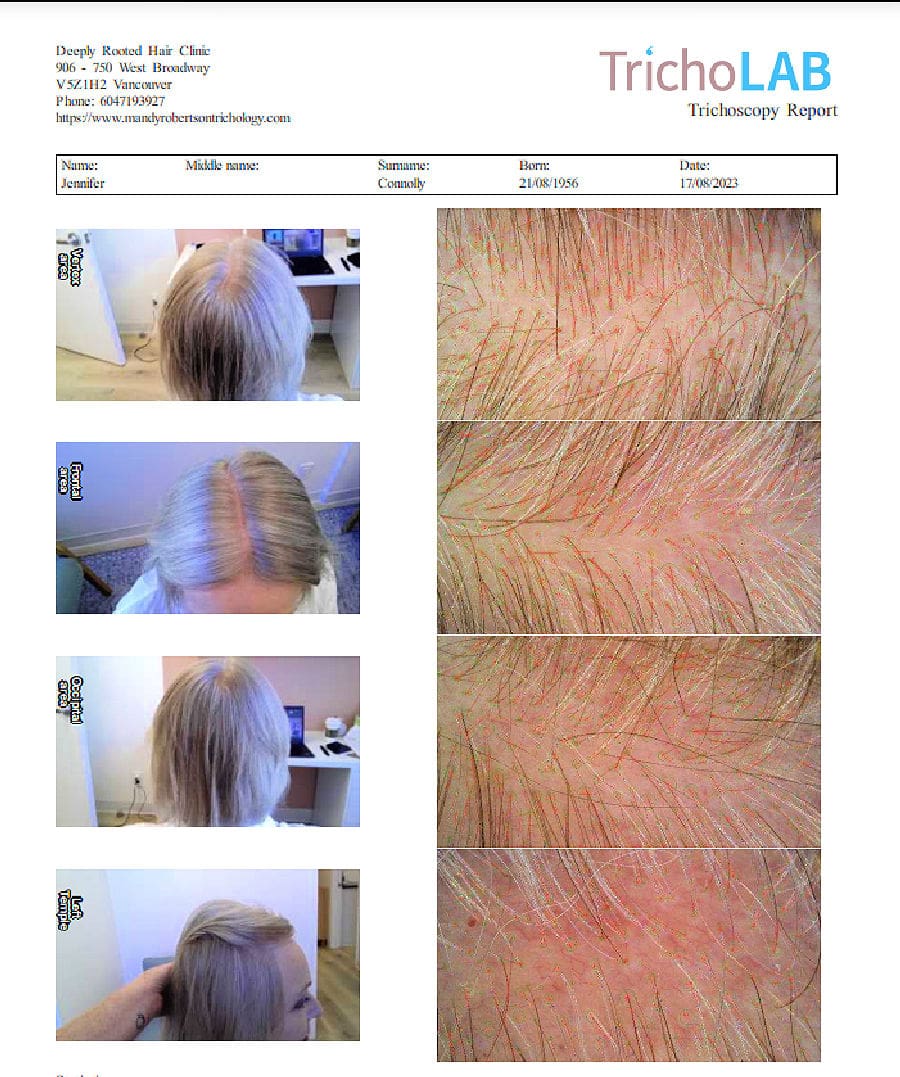
The results showed I had several types of hair loss. There were microscopic signs of Androgenetic Alopecia (AGA) with miniaturized hairs and fewer hairs per follicular unit. Since miniaturized hairs are still present, I may be able to reverse some of this hair loss and prevent further progression.
It also showed Telogen Effluvium (TE), possibly brought on by stress, which speeds up the arrival of genetic hair loss. The report also showed I have mild Seborrheic dermatitis (SD), which is an inflammatory skin condition that is caused by Malassezia yeast.
My trichologist recommended I wash my hair twice a week with a ketoconazole shampoo like Nizoral, which kills yeast on the scalp that causes inflammation in the hair follicles. She also suggested I try laser light therapy, which has been shown to be very helpful with hair loss.
Lifestyle Changes and Home Remedies
Natural remedies for thinning hair often focus on promoting scalp health, improving hair strength, and addressing potential nutrient deficiencies. I’ve tried and am using most of them.
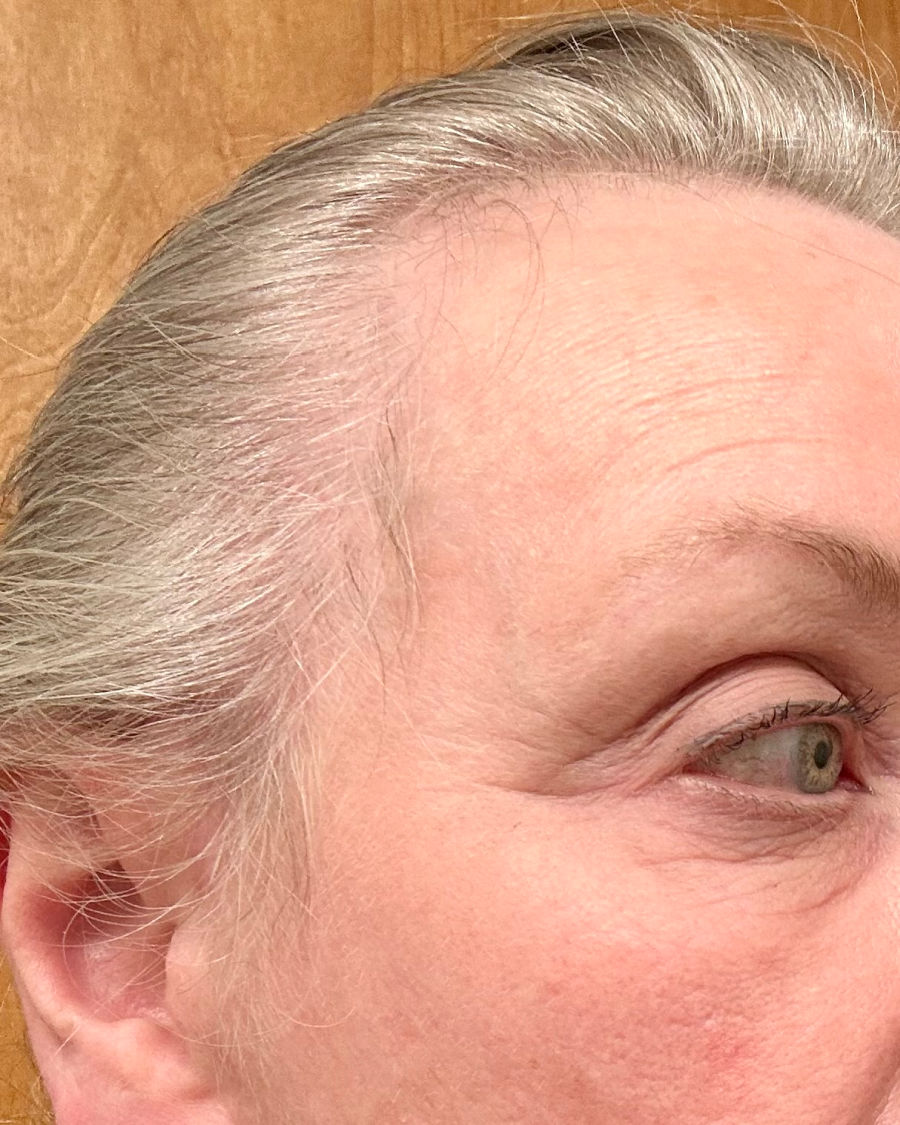
Here are some commonly suggested natural remedies:
Scalp Massage
Regular scalp massages can increase blood flow and potentially stimulate hair growth. Using oils like coconut, almond, or olive oil during the massage may also nourish the hair roots but will also necessitate shampooing, so it’s best to do this right before your regular hair wash. Here’s a crop of mechanical scalp massagers you could try…or just use your fingers like I do.
SCALP MASSAGERS
Saw Palmetto
Often used in herbal remedies and expensive Hair loss supplements like Nutrafol. Saw Palmetto may help reduce hair thinning in cases related to hormonal imbalances.
Essential Oils
I’ve read of certain essential oils, such as rosemary, peppermint, and lavender, for stimulating hair growth but I haven’t tried them personally or found any clinical reports of it actually helping.
Ketoconazole shampoo
Using a ketoconazole shampoo like Nizoral every few days will help reduce inflammation of the hair follicles. Tests have shown that 2% options are the best, which is over the counter in Canada and by RX here in the US, but even a 1% will help, so that’s what I’m using.
Dietary Changes
Make sure you’re eating a nutrient-rich diet, which is crucial for hair health. Foods like fish, nuts, seeds, leafy greens, and lean meats are excellent choices.
My trichologist recommends that in addition to your regular supplements, you can consider taking 320 mg of saw palmetto a day along with 400 mg of pumpkin seed oil per day. Saw palmetto and PSO have mild anti-androgenic effects, and PSO has anti-inflammatory effects. She also recommends taking a vitamin D supplement of 1,000 – 2,000 IU) daily.
Avoid Trauma to The Hair
Use a wide tooth comb on damp hair and a soft brush on dry hair. Avoid unnecessary tugging or tight ponytails, which puts unnecessary stress on the hair. Brush gently to distribute natural hair oils. I’ve switched to a Zuvi Halo Hairdryer and find it the most gentle for my hair and leaves it nice and shiny.
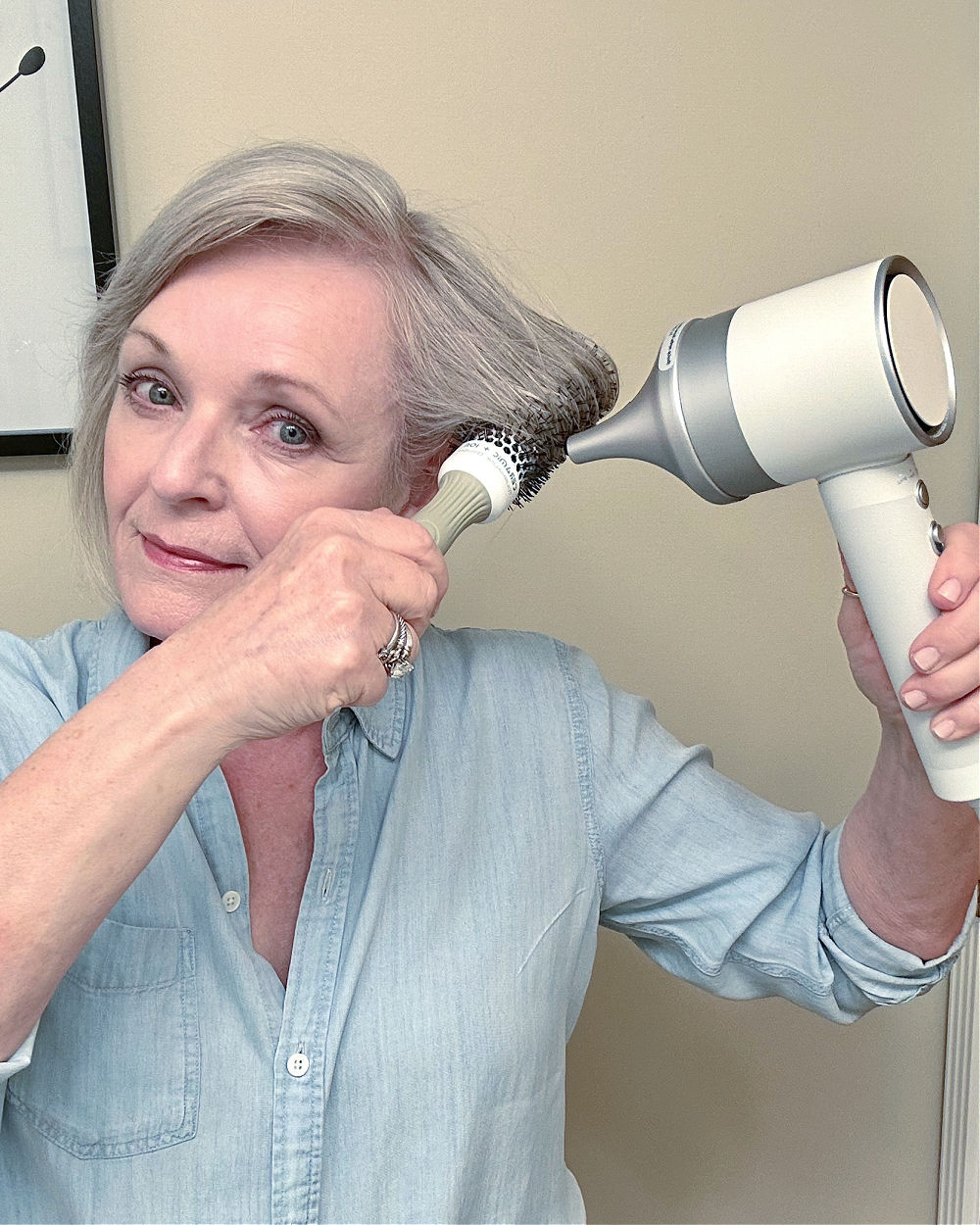
Zuvi has generously offered my readers a special discount. Use code Jennifer12 for 12% off your order here. (*You can also use Jennifer5 for an extra 5% off if the Zuvi site has a promotion already.)
Cosmetic Solutions For Women With Hair Loss
Hairpieces, wigs, and hair extensions are all viable cosmetic options that can help improve a woman’s confidence who is struggling with hair loss.
What I’m Doing to Treat My Thinning Hair
It would be easier to list what I’m not doing to help slow my hair loss. You can also read about The Haircare Products I’m Using For My Thinning Hair.
I’ve already mentioned the topical minoxidil and gentle hair dryer. I now wash my hair with this Nizoral Ketoconazole shampoo twice a week. I take a ton of suppliments which I shared here.
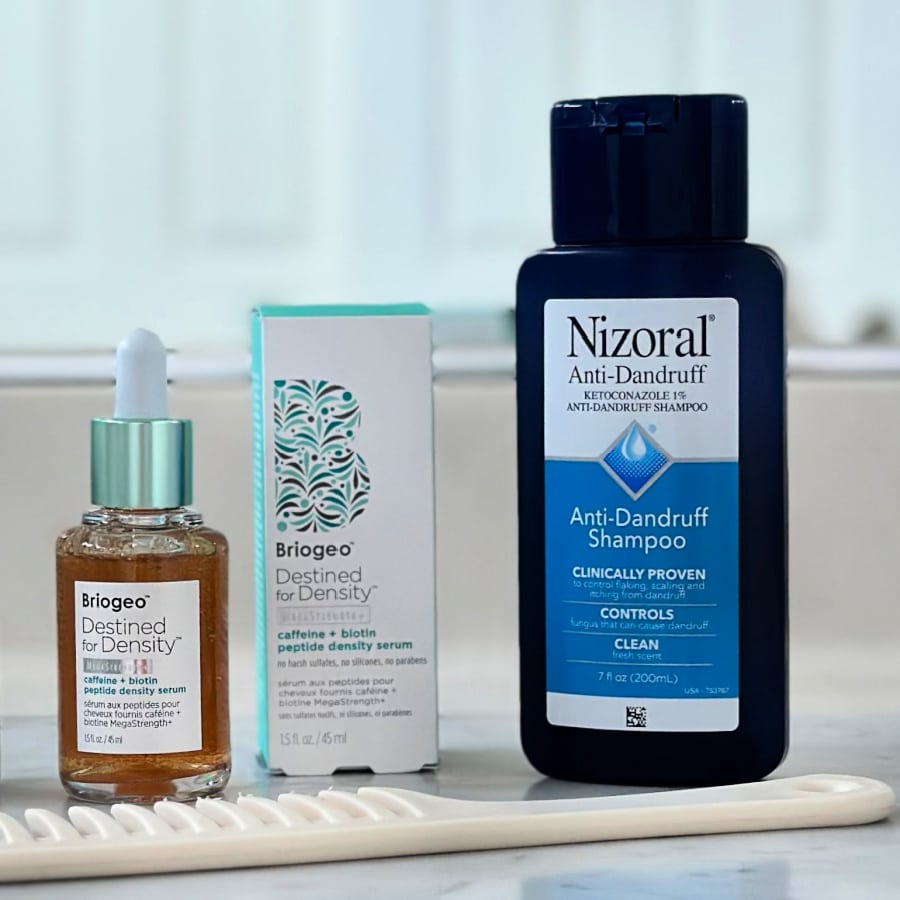
Caffeine Hair Serums
There is some clinical evidence showing that topical caffeine can stimulate hair follicles and increase hair growth, so I’ve begun testing a few. I bought the Briogeo Destined for Density caffeine, biotin, and peptide serum. I also bought the Vegamour Gro Hair Serum for Thinning Hair, which also contains caffeine.
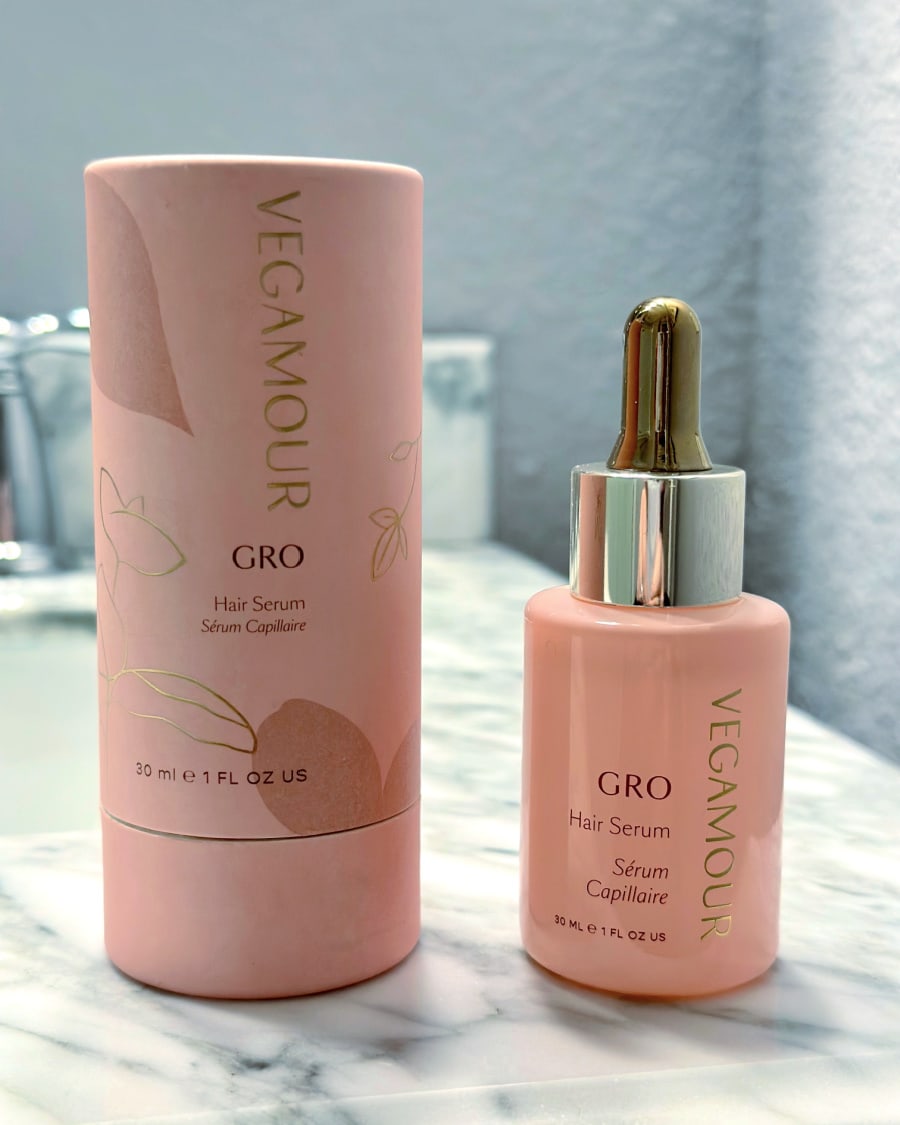
Neither leaves a film on my hair or makes it feel greasy. That said, I prefer the ease of application and cleaner feel of the Vegamour, so I am applying it each night on a dry scalp and massaging it in.
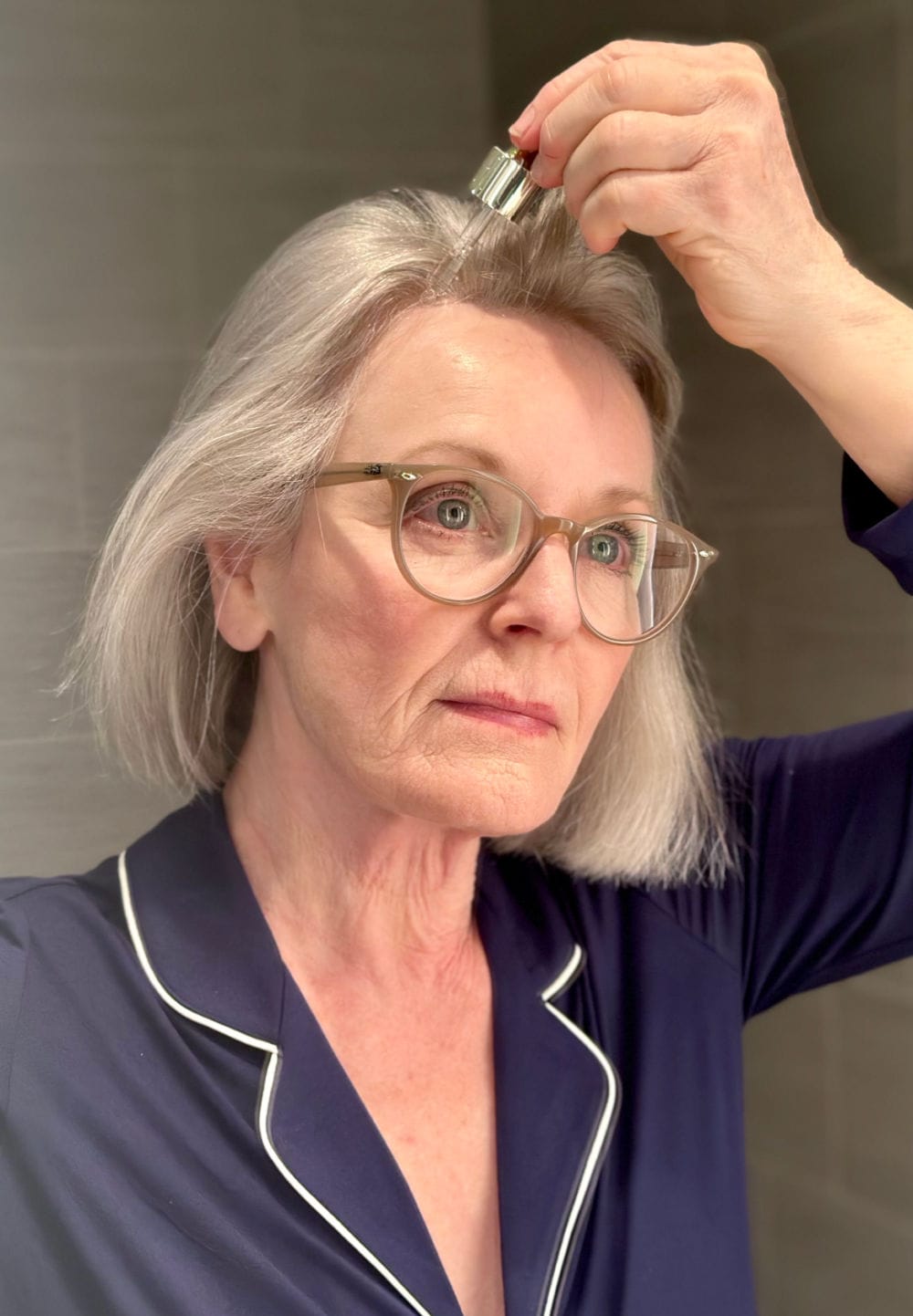
I’d been taking Nutrafol for several years with mixed results and stopped taking it on the advice of my Trichologist. She felt its ingredients could be duplicated for a lot less money. I continue to use Rogaine 5% morning and night and am considering replacing it with low-dose oral Minoxidil.
I’ve also been using this Capillus Pro Cap S1, which the brand generously sent me to try.
The inside of the cap is covered with medical-grade laser diodes, which emit safe, low-level laser light at wavelengths that are believed to stimulate hair follicles, improve blood circulation, and increase the production of adenosine triphosphate (ATP), which can energize and promote the activity of the hair follicles.
It’s designed to provide a convenient, non-invasive solution for people struggling with hair thinning and loss, particularly androgenetic alopecia (pattern baldness). I use it for just 6 minutes a day, and it’s auto-programmed to turn off at the end of each session. They also have an app you can download to your phone to keep track of your progress.
Do you struggle with thinning hair or have hair loss? I’d love to hear what you’re using.

Jennifer, something else you might want to look into is hyperbaric oxygen therapy. The increase in oxygen yields a broad variety of positive effects. Some of it’s benefits include reduces inflammation, stimulates the formation of new blood vessels, accelerates healing, reduces stress and anxiety, among many others. I have done it many times for issues different than yours. It may or may not help hair loss but it might be worth looking into.
That sounds amazing Mary. Where would I get that? I’d love to try it.
Hi Jennifer, what specialist did you go to in the Bay Area to determine what type of hair loss you have?
I saw a Trichologist in Vancouver, Canada but their are many to source with a google search.
I was first attracted to your blog because our hair style is very similar. I am very fortunate not to have scalp problems, but do have a receding hairline which is genetic and also avoid windy days for photos. 🙂 What has helped me the most is an excellent hairstylist and a good cut with feathered bangs. She foils my hair about every 9 months with light blond that is easing me into gray. The color also adds much needed body to my fine, straight hair.
I’d like to know more about toppers. Do you wear one? Where is the best place to buy these? I have a large head size and when I tried a wig for fun as a teenager it wasn’t comfortable to wear for a long period. I’m thinking 60 years later they may be much improved. 🙂
I don’t wear a topper but if I was going to wear one, I’d go to a wig store and get one made from human hair and get it dyed to match my color.
Hi, Jennifer –
I have been dealing with thinning hair since before menopause. My derm then told me then that there is so much research being done on this that a breakthrough is expected any minute — and that was more than 20 years ago! A more recent derm who is a hair specialist recommended “men’s” 5% minoxidil which I have used off and on. I used it consistently for the 6-8 weeks she recommended. At the follow up appointment, she said it was working for me. However, I find it makes my hair “crunchy” when I prefer to have zero product on my hair. Therefore, I am inconsistent. I wash my hair 2x per week with a purple shampoo. I think since I have more silver the scalp is not as noticeable. I consulted with another doctor re PCP, and he said it doesn’t work for everyone and was not encouraging. He recommended red light treatment, which I have not tried.
I wanted to let you know that the BEST PRICE I’ve found for men’s 5% minoxidil is Costco! You can get six of the 2 ounce bottles for $17.99! It is not always that low, but it is currently, and will be again. It’s also on their website.
I take collagen, biotin, vitamin D, etc., but I’m not sure that has done anything for me. I will try the saw palmetto and pumpkin seed oil!
Thanks for your honesty and research.
Thank you for sharing Julie! I know consistency is critical for it to work and you must maintain it.
I was diagnosed with the same thing as you, Jennifer, and my dr recommended the oral minoxidil at a very low dose (1/4 tablet to start), along with the Nizoral shampoo and also Clobetasol shampoo or solution as an anti-inflammatory agent, plus the red light cap for 10 minutes each day. I began to see significant results after about six months. After a year, the bald areas at my temples had completely filled in and the hair over my whole head was very full. I did notice that I had a few stray hairs growing out of my ears, but I was able to take care of those with some Nair! 🙂 Hooray!!
Thank you so much for sharing this Pat! I will look into these and ask my Dr.
Hi Jennifer, I have struggled right along with you. In 2021 I lost 65 pounds and a lot of hair. My primary doctor assured me it was the sudden weight loss TE and would grown back. It did not and I saw a dermatologist. She suggested Nutrafol and tested my ferritin (which is normal) and also told me it would grow back in a few months. I used Nutrafol for four months with absolutely no change except maybe more hair loss. I eat a healthy diet of whole foods, exercise, take a few supplements, etc. but continue to lose hair. I purchased a wig but haven’t worn it yet because even after having it thinned and styled, still looks foreign to me. I was told I don’t have enough hair to fasten a topper to. I’m 70 and have always had very fine, straight hair that I never appreciated. I miss my lovely hair now!
Congrats on the weight loss, but the hair loss is so painful, I’m sorry! Have you tried topical Minoxidil? I’m surpised your dermatologist didn’t mention it or the low dose oral option. I think you need to try a new deramatologist.
Thank you so much for sharing your journey and all this information! You are brave and a great example to all of us. I love the community and all the comments. Thank you!!!!
I love this community too!